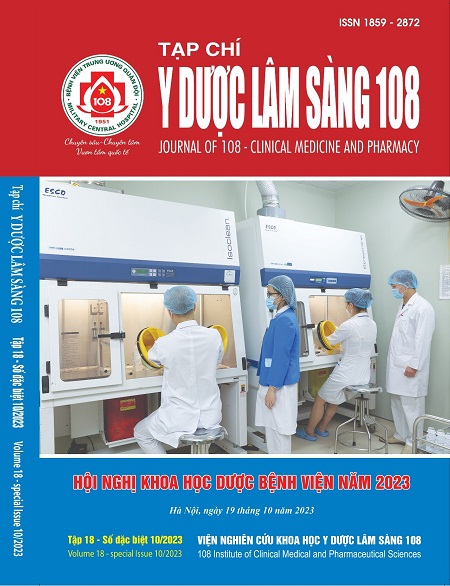Nephrotoxic antibiotics: Its characteristics when being used on adult patients with severe burns at Intensive Care Unit, Le Huu Trac National Burn Hospital
Main Article Content
Keywords
Abstract
Objective: To analyze the characteristics of the use of nephrotoxic antibiotics on burn patients at Intensive Care Unit, Le Huu Trac National Burn Hospital. Subject and method: Retrospective description of the medical records of 84 adult patients (the age from 18 to 60 years old) who received colistin or amikacin or tobramycin or vancomycin in severe burn treatment from January 2020 to December 2020. Result: The proportion of patients using a nephrotoxic antibiotic listed in follows: Colistin (15.48%); amikacin (2.38%); tobramycin (72.62%); vancomycin (1.19%). Dosing regimens: Average loading dose of Colistin was 8.75 ± 1.21MUI and maintenance dose of 8.55 ± 1.36MUI/day (4.18mg/kg/day). Tobramycin was 232.62 ± 39.30mg/day; amikacin was 1000mg/day; vancomycin was 2.5 ± 0.71g/day. The average number of days of treatment was 8.88 ± 4.96 day (from 3 to 28 day). The two-antibiotic regimens succeed in 60% cases (in total two-antibiotic regimens were used). Among the two-antibiotic regimens, the combination between tobramycin and piperacillin/tazobactam presented as 33.33% successful cases. There were two combinations of antibiotics in success with following results: The combination between tobramycin and cefoperazone/sulbactam had 80% successful cases, meanwhile, the combination between colistin and carbapenem owned 72.73% successful cases. There were 6 cases with AKI (Acute kidney injury) including 5 cases used tobramycin and 1 case used colistin. The percentage of total body surface area of burn patients with AKI was 62.33%, and full-thickness burn area for these cased was 27%. Conclusion: The use of nephrotoxic antibiotics in burn adult patients at Intensive Care Unit, Le Huu Trac National Burn Hospital was suitable for guidelines with majority as tobramycin use (72.62%). The two-antibiotic regimen was popular with one nephrotoxic antibiotic in this combination. As a result, there were 5/6 cases with AKI (83.33%) which uses tobramycin in treatment period.
Article Details
References
2. Bộ Y tế (2020) Hướng dẫn thực hiện quản lý sử dụng kháng sinh trong bệnh viện. Nhà xuất bản Y học.
3. Pogue JM, Ortwine JK, Kaye KS (2015) Optimal Usage of Colistin: Are We Any Closer?. Clin Infect Dis 61(12): 1778-1780.
4. Nguyễn Đạt Anh (2016) Hướng dẫn điều trị kháng sinh theo kinh nghiệm. Nhà xuất bản Y học.
5. Lương Quang Anh (2014) Đánh giá tình hình sử dụng kháng sinh tại Khoa Hồi sức cấp cứu, Viện Bỏng quốc gia năm 2014. Báo cáo kết quả nghiên cứu đề tài cấp cơ sở.
6. Nguyễn Thị Thanh Minh (2011) Khảo sát tình hình kháng kháng sinh và đánh giá hiệu quả một số liệu pháp điều trị kháng sinh đối với bệnh nhân bỏng nặng tại khoa Hồi sức cấp cứu, Viện Bỏng Quốc Gia. Luận văn Thạc sỹ dược học, Trường Đại học Dược Hà Nội.
7. Rocco M, Montini L, Alessandri E, Venditti M, Laderchi A, De Pascale G, Raponi G, Vitale M, Pietropaoli P, Antonelli M (2013) Risk factors for acute kidney injury in critically ill patients receiving high intravenous doses of colistin methanesulfonate and/or other nephrotoxic antibiotics: A retrospective cohort study. Critical Care 17(4): 174.
8. Dương Thanh Hải (2016) Nghiên cứu độc tính thận trên bệnh nhân sử dụng colistin tại Khoa Hồi sức tích cực, Bệnh viện Bạch Mai. Luận văn Thạc sỹ dược học, Trường Đại học Dược Hà Nội.
9. Paul M, Bishara J, Levcovich A, Chowers M, Goldberg E, Singer P, Lev S, Leon P, Raskin M, Yahav D, Leibovici L (2010) Effectiveness and safety of colistin: prospective comparative cohort study. J Antimicrob Chemother 65(5): 1019-1027.
10. Collins JM, Haynes K, Gallagher JC (2013) Emergent renal dysfunction with colistin pharmacotherapy. Pharmacotherapy 33(8): 812-816.
 ISSN: 1859 - 2872
ISSN: 1859 - 2872
